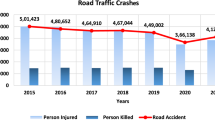Abstract
The acceptance of route guidance advice by motorists is expected, to occur only whenever such advice is experienced to be valid and reliable. Three major factors may cause route guidance systems to provide motorists with unreliable advice:
-
(1)
the traffic information constituting the basis for guidance advice is inaccurate;
-
(2)
the impact of a large fraction of motorists responding to the guidance, and the subsequent overreaction that occurs, is ignored whenever the guidance advice is being set; and,
-
(3)
concentration effects may occur and induce a higher level of (unpriced) congestion when drivers are provided with better information.
Access this chapter
Tax calculation will be finalised at checkout
Purchases are for personal use only
Preview
Unable to display preview. Download preview PDF.
Similar content being viewed by others
References
Arnott, R., A. de Palma, and R. Lindsey (1994) “Dynamic Model of Peak Period Congestion with Heterogeneous Commuters”, Journal of Transportation Economics and Policy, forthcoming.
Ben-Akiva, M., A. de Palma, and I. Kaysi (1991) “Dynamic Network Models and Driver Information Systems”, Transportation Research Vol. 25A, No.5.
Bonsall, P.W. and A.D. May (1989) “Evaluation of In-Vehicle Route Guidance Systems”, paper presented at the 5th WCTR Yokohama, Japan.
Kaysi, I. (1991) “Framework and Models for the Provision of Real- Time Driver Information”, Unpublished Ph.D. Dissertation, Department of Civil Engineering, MIT November 1991.
Kaysi, I., M. Ben-Akiva, and H. Koutsopoulos (1993) “An Integrated Approach to Vehicle Routing and Congestion Prediction for Real-Time Driver Guidance”, Transportation Research Record, No. 1408.
Kaysi, I., M. Ben-Akiva, and A. de Palma (1994) “Design Aspects of Advanced Traveler Information Systems”, Compendium of Papers 1992 Capri Seminar on Urban Traffic Networks.
Author information
Authors and Affiliations
Editor information
Editors and Affiliations
Rights and permissions
Copyright information
© 1996 Springer-Verlag Berlin. · Heidelberg
About this paper
Cite this paper
Ben-Akiva, M., de Palma, A., Kaysi, I. (1996). The Impact of Predictive Information on Guidance Efficiency: An Analytical Approach. In: Bianco, L., Toth, P. (eds) Advanced Methods in Transportation Analysis. Transportation Analysis. Springer, Berlin, Heidelberg. https://doi.org/10.1007/978-3-642-85256-5_19
Download citation
DOI: https://doi.org/10.1007/978-3-642-85256-5_19
Publisher Name: Springer, Berlin, Heidelberg
Print ISBN: 978-3-642-85258-9
Online ISBN: 978-3-642-85256-5
eBook Packages: Springer Book Archive




